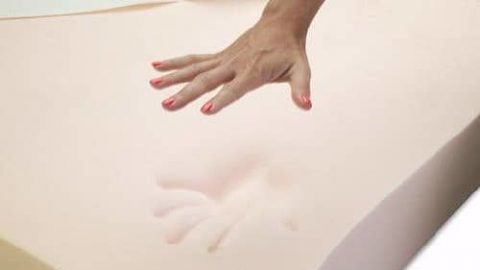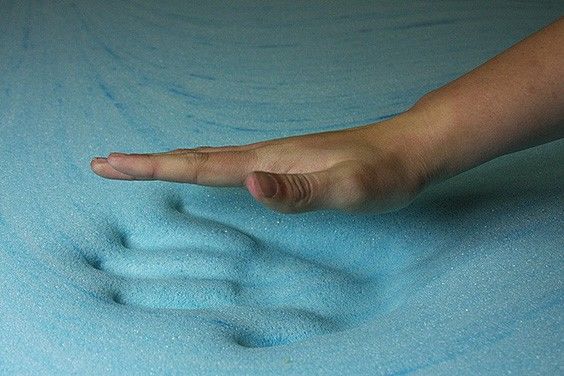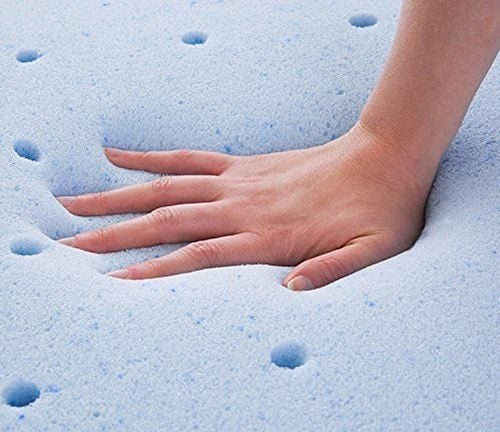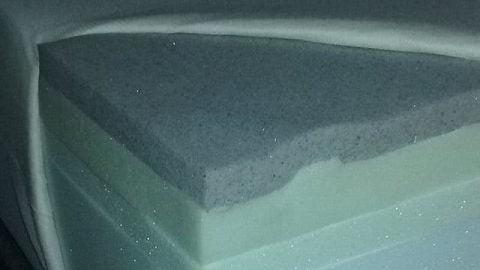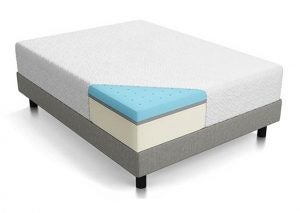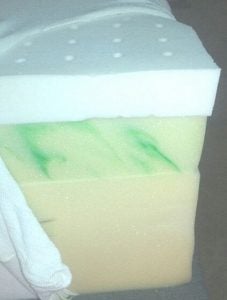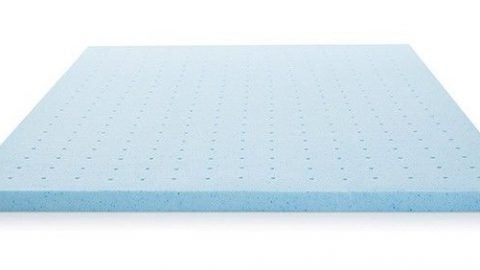It’s an exciting time to shop for a mattress. You can open yourself to a world of possibilities when you’re looking for a quality mattresses online. As you browse, you’ll come across a number of different foams used in sleep products, and one of these is memory foam.
If you’re considering purchasing one for yourself, there are many aspects you must keep in mind. It’s my goal in this comprehensive memory foam mattress buying guide to give you all the pertinent information you need to know including:
-
- What memory foam is
- What to look for
- Densities
- Indentation load deflections
I know you’re excited to order your new memory foam mattress. However, I encourage you to read this entire article before you make your final decision as even a seemingly minor detail may cause you to make a significant investment in the wrong product.
Check out our list of the top rated memory foam mattresses.
What is Memory Foam?
While we typically associate memory foam with sleep products, its original production was geared toward use for NASA in the 1970’s. What many don’t realize is that it was never used in the space program. Many falsely claim that it was used by astronauts who are subjected to high G forces. Rather, it was actually a material that would help both pilots and passengers increase their chances of sustaining crashes and other impact more safely. The foam is visco elastic, and this makes it able to isolate motion and conform to the natural curvature of the body.
It didn’t take long for manufacturers to recognize the quality of this type of comfort, and it quickly made its way into the mattress industry. Since this time, there have been a number of modifications made to traditional memory foam to ensure the best quality for your needs.
Types of Memory Foam
There are many types of foam on the market. If you believe you want to go with memory foam, it’s important to ask yourself a few questions as there are different types available which each feature their own unique benefits. Before you continue browsing, I’d first like to introduce you to these types and give you a little bit of information about each in order to help you narrow down your choices.
— Traditional Memory Foam
-
- Introduced in the mid-1990’s
- Designed for cradling support to enhance circulation and decrease stress on your joints
- Known to absorb heat, so this may not be a good choice if you tend to sleep hot
— Open Cell Memory Foam
-
- Has a quicker response, so you can avoid that “sinking in” feeling often associated with traditional memory foam.
- Better able than traditional memory foam at dispersing heat.
- Able to respond to your body temperature to keep it properly regulated for restful sleep.
— Gel Memory Foam
-
- Helps in the reduction of pressure points
- Better at dispersing heat.
- More on gel memory foam mattresses here.
You may want to read: How Long do Gel Memory Foam Mattresses Last?
Memory Foam Mattress Makeup
Many mattresses on the market combine several layers of various materials, and their properties work together to offer a combined unit that offers different levels of support and comfort. As you shop your memory foam options, it’s important to keep in mind that memory foam is ideal for use in the comfort layers. Due to its properties, this material does not serve well as a foundation.
Despite the type of memory foam you choose, they all offer some similar features on the comfort layer. This typically consists of the top half of the mattress layers, and just a few of the benefits include:
-
- Due to its ability to conform to your body, it offers the contour you need to reduce pressure points. In fact, many praise this material as being the best in point elasticity.
- It offers a level of comfort many consumers enjoy and don’t experience with other foam types.
- Works well with other foams in the provision of conformity and contour while minimizing negative aspects such as decreased breathability and the feeling you are sinking into the mattress.
— Love-Hate Relationship
The attraction to or away from memory foam is, with many consumers, a love or hate relationship. This is because we are all unique. Some people enjoy the feeling when the materials heat up and envelop your body. However, others simply don’t. Because the line is so divisive, you may already know if you’re dead-set on purchasing some type of memory foam product.
In many ways, memory foam mattresses are similar to airbeds and waterbeds. For starters, their interiors each flow away from pressure rather than compressing. Furthermore, they only respond to pressure under the area where it’s being applied. Memory foam does offer a unique benefit that may make the skeptics who have never experienced memory foam reconsider. One of the most convincing is the fact that, since they absorb shock, they can make a great product for someone who has a sleeping partner who moves around a lot.
— Considering Heat and Pressure
Heat and pressure make a difference, especially when dealing with traditional memory foam. Due to its makeup, memory foam tends to soften when body heat is applied, and this causes it to become semi-solid. Furthermore, since it’s not as open-celled as other products like latex, it takes longer for memory foam to resume its original form. This can be an attractive quality for those who are able to quickly find a comfortable position and don’t move around a lot.
When to Choose a Memory Foam Mattress
So, let’s go ahead and answer the questions you’re likely asking yourself: when is memory foam the appropriate choice? There are a number of circumstances that may very well warrant a confident purchase of this type of material. For starters, it features a unique combination of properties that are a good fit for those who suffer with aches and pains as it very efficiently evens out body weight and conforms to your spine’s natural curvature. However, it’s important to keep in mind that there are other materials which can be closely mirrored to memory foam when it comes to pressure relief. Therefore, you shouldn’t purchase a memory foam based on this preference alone.
— Stable Cradle
Another quality memory foam offers that can be attractive to many consumers is the fact that, since body heat and pressure is required to cause the material to soften, areas you aren’t lying on will resume their firmness. Therefore, the area you lay in essentially becomes a “stable cradle” that can offer you the feeling of security you may need to sleep well.
If both of these qualities are ones you believe would work for you, you’re going to love the fact that, if you have a restless sleeping partner, you can expect memory foam to be more effective against motion transfer. It’s ability to absorb energy and isolate motion is superior to many other materials used in the industry.
— An Investment That Lasts
You work hard for your money, and you likely want to invest in a product you can have a high expectation of lasting for a long time. In this case, memory foam mattress layers are a great option. They’re known to last much longer than polyfoams in the comfort layers as this is where most of the compression takes place. However, you do get what you pay for, and, for a typically higher price, there are other materials that can last longer than memory foam including:
-
- Latex
- Natural fibers
- High-quality innerspring
— Sleeping Position Compatibility
Something that’s easy to overlook is your primary sleeping position. There’s likely one or two in particular that you find yourself in when you experience peak comfort. Depending on yours, memory foam may or may not be for you. The following sleeping positions can be compatible with memory foam:
-
- Back sleepers- this is because the foam aligns your spine
- Side sleepers- this can help reduce pressure points commonly experienced in this position
If you are a stomach sleeper primarily, you may want to consider other types of mattress material. Since you tend to sink into memory foam, you may experience feeling that you’re surrounded considering your face will be close to or in contact with the material. If you’re a combination sleeper, you may find that you’re able to compromise in this minor area and enjoy the pressure relieving benefits memory foam has to offer.
When Not to Choose a Memory Foam Mattress
Here at The Sleep Judge, it’s not our job to sell you a mattress. Instead, it’s our mission to help guide you in finding the product that’s the best fit for you. Therefore, if a memory foam mattress isn’t likely to be a good choice for you, we want to get straight to the point and let you know! There are a few properties of this foam type that may be an indicator you should consider another material.
— Not the Go-To Choice for Hot Sleepers
Memory foam is known to retain heat, and this can be a problem for those who are sensitive to a high body temperature during sleep. You may not have known that the body temperature slightly decreases as you drift into the deeper stages of sleep, and it’s during these stages that the restorative processes that provide rejuvenation take place.
While there are many products available such as gel foam that are designed to increase breathability, the fact remains that foams that are open-celled can typically help keep the sleeper cooler during the night. Therefore, if you tend to sleep very hot and this is a serious issue for you, memory foam may not be the best choice.
—Considerations for Lumbar Support
While spinal alignment can be easily attained using memory foam, what many overlook is the fact that it can often fail in providing proper lumbar support. This is because the material “melts” under heat and pressure. Since the lumbar area doesn’t make contact with the materials, this can cause you to lose support here.
s gel foam that are designed to increase breathability, the fact remains that foams that are open-celled can typically help keep the sleeper cooler during the night. Therefore, if you tend to sleep very hot and this is a serious issue for you, memory foam may not be the best choice.
— Can Be Difficult to Move Around
I’m guessing, if you’re seriously considering a memory foam mattress, you’re not looking for one with a high degree of bounce. However, in case you weren’t aware, memory foam does take a moment to return to its original position after pressure is released. Therefore, it can be a little more difficult to move around in these mattresses as compared with other materials available.
— An In-Between Product
While some may be completely for or against memory foam, there are others who may have a few things they don’t like but may be willing to compromise considering some of the benefits they enjoy. For example, maybe you tend to sleep a little on the hot side but don’t move around a lot during sleep and want a solution for the pressure points created by your broad hips or shoulders. Whatever the issue may be, you may find the happy medium you’re looking for when you find a product with a limited thickness. You can even shop for products containing memory foam in the second or third comfort layer. This provides a degree of memory foam benefit without overwhelming you with potential setbacks.
Don’t Put Too Much Faith in Advertising
If you’re reading this, you’ve obviously heard of memory foam and have a good idea of what it is. However, consider what you really know about this material. If you heard about the material on television or other forms of advertising, it’s important to keep in mind that advertisements are paid for by manufacturers and retailers with the sole intention of making a sale. Therefore, there is a lot of misinformation that can cause you to make a purchase based on misconceived pretences.
Oftentimes, comparative information is inaccurate. Furthermore, it can be difficult for consumers to compare memory foam to materials that offer similar benefits due to the fact that there are different properties present such as firmness levels, pressure relieving properties, and densities.
A Note for Stomach Sleepers
Most of us have one or two primary sleeping positions that offer us the comfort we need to rest. If you tend to sleep on your stomach, you may find memory foam to be too visco elastic for your needs. As you sleep, your body will sink deeper into the product, so this may be a better option for those who sleep on their sides or backs.
How to Choose a Memory Foam Mattress
So far, we’ve discussed what memory foam is and the general pros and cons. If you’ve decided this is the type of material you want to pursue, it’s important that you understand what to look for when buying a memory foam mattress. There are some very specific features you should look for to help find the product best tailored to fit your unique needs.
— A Look at Memory Foam Density and Indentation Load Deflection
There are two very important aspects you need to consider as you shop, and those are firmness and durability. The wrong firmness level can cause restless nights, and you definitely want to ensure your mattress will stand the test of time. The good news is that you can get a good idea of both of these aspects when you pay attention to two specific mattress specs as you shop.
• Firmness
You may think it would be impossible to get an idea of firmness shopping online. However, when you take a look at the indentation load deflection, you can make a more informed decision than you probably realized. The higher the ILD rating, the firmer you can expect the product to be.
There is quite a range, so I’ll let you know the softer and harder end of things. A product with an ILD of 12 would be very soft while 50 would be a very firm product. Therefore, if you prefer something in the middle, that would put you somewhere around the mid to upper 20’s. As you analyze the top layers, you’ll typically find an ILD of around 12-16 for comfort. However, when you make your way down to the support layers, they typically increase. Your overall ILD considers all the layers as a combined unit.
• Memory Foam Mattress Life
When it comes to durability, this can be difficult to determine, even if you try out a product before making a purchase. However, when you know one magic number, you can get a much better idea of what you’re getting into. Memory foam density ratings are a good indicator of a quality or sub-par product. To make it simple for you, here is a memory foam density scale to help guide you as you shop:
A density this high in memory foam is a good indicator that the product will last. In some cases, these products can maintain their integrity for as long as 8-12 years. It’s important to point out that, if you carry a lot of weight, you should look for a product with at least a 5 lbs./ft³ density.
Anything 3.5 lbs./ft³ or lower will be of a lower quality. If your budget won’t allow you to purchase a mattress with the right density level, I would recommend you check out memory foam toppers. This allows you to take advantage of quality memory foam at a fraction of the cost.
A memory foam product with a density this high is considered high density, and this is the highest quality you’re going to find on the market. I will warn you that you can expect a hike in the cost, but it can prove worth it if you’re looking for a product that will give you the most years of enjoyment or if you carry much more weight than the average person.
— Consider Where the Foam Was Manufactured
Part of the quality you can expect from your mattress will depend on where it’s made. This is because of the various quality controls and industry standards in place in different areas of the world. As you shop, a few places you can count on include:
-
- United States
- Canada
- Europe
You may find yourself tempted to purchase a product manufactured in China, and this is often due to an attractive price tag. While I can’t speak for all products, I would say, in general, to beware. It’s usually true that you get what you pay for, and this is no different when it comes to mattresses. Just some of the compromises many places with lower standards make include:
-
- Use of lower-quality ingredients
- Use of cheap filters to make their densities seem higher than they really are
- Substitution of unsafe chemicals to cut costs
Aside from these issues, you have to consider other Chinese products that have proven to be nightmares. From lead found in children’s toys to toxic ingredients found in toothpaste and more, this is just not something I’m willing to risk compromising on when it comes to a sleep product.
I also understand that money can be tight, and you want to get the best deal possible. I just want to reiterate that the “best deal” can’t be completely determined based on cost alone. A $500 mattress that lasts 4 years is a much worse deal in the long run than a $1,000 product that lasts 12. By saving now, you may find yourself mattress shopping all over again in just a few short years.
— Look for Standardized Testing Certifications
It can be easy to dismiss the stamps of approval from testing organizations that are in existence to help ensure the quality of many products. However, these certifications have a lot to tell you. In the mattress industry, you want to be on the lookout for products that are Certipur-US® certified. When you see their seal of approval, just some of the qualities of the foam you can be sure to count on include:
- They are made without phthalates which are regulated by the Consumer Product Safety Commission
- They are made without formaldehyde
- They are made without mercury, lead and other heavy metals
- They are made without PBDE flame retardants
- They have a low concentration of volatile organic compounds. These are the components associated with the chemical smell that you often experience with new products.
— Consider the Advice of Real Customers
You can spend countless hours researching the right mattress for you. However, few things will help you more than reading real reviews from consumers who have already tried the product. Unlike just a few short decades ago, we now have the power of the Internet at our fingertips. Here, you can hear firsthand accounts of how a product you may be considering holds up to expectations.
There are dozens of comprehensive memory foam mattress reviews you can take advantage of, and you can explore the good, the bad, and the ugly. Here at The Sleep Judge, we make it our mission to provide our visitors with trustworthy reviews you can count on. We offer many reviews of various products that allow you the chance to see for yourself how these products worked for us.
It’s important to keep in mind as you do browse reviews outside The Sleep Judge that many people only take the time to write them when they aren’t happy with the product. Therefore, if you find one that generally seems to be making consumers happy but just has a few negative comments, it may be worth looking into more. Of course, take the time to read the negative comments as you may discover a problem you aren’t willing to compromise on. Just don’t allow a few bad reviews to send you running.
— Sleep Trial Period
If you’ve done your research and you’re still not sure if a product will be right for you, make sure you find out whether or not the company offers a sleep trial. I have experienced products that offer trial periods as long as 200 nights. In these cases, the manufacturer will allow you to actually use their product for a set amount of time. This allows your body to adapt to the materials. Furthermore, you typically get a good amount of time to really decide if the product is right for you. However, if for any reason you’re not satisfied, they will usually arrange for a local service provider to pick up the product and dispose of it free of charge. You then receive a full refund.
The sleep trial period can give you a good idea of the overall quality you can expect of a particular memory foam product. It’s not uncommon for less expensive options not to offer a sleep trial at all, and this is usually because they would quickly begin to lose money as dissatisfied customers began returning sub-par mattresses when they don’t hold up. However, a company that’s confident enough to allow you a test run is one that feels pretty confident in the construction of their mattress.
• Company Reputation
Another thing you should consider before making a purchase is the reputation of the company. Not only will this give you a good idea of the quality of the product you can expect from them, but it can also indicate:
- Proper business ethics, a quality that can prove beneficial when dealing with customer service.
- Positive business practices
- Social responsibility
- Customer focus
- Reliability
Few things are worse than making a sizable investment only to find that the company is no longer interested in hearing from you once the check clears. A company with a positive reputation is indicative of one you can count on. Furthermore, those who have been in business longer are more able to make predictions about the durability of their mattresses.
• Sleep Trial Period
While density can give you a good idea of the durability of a particular product, memory foam in general is known to last. You can typically expect a quality product to last between eight and 12 years. However, there are always improvements being made in the industry, and there are now products with claims to last up to 25 years.
However, no matter how much you invest, your mattress will begin to wear out over time. Regardless of how quickly the symptoms arrive, just a few you should be on the lookout for include:
- Sagging
- Body impressions
- Softening
- Lumps and bumps
The good news is that there are things you can do to extend the life of your memory foam mattress. A great place to start is to rotate your mattress every 90 days. This switches up the weight distribution on the product. Some are also able to be flipped, so check to see if this is the case as you shop. I would highly recommend that you use a quality mattress protector. Not only do these products help protect the cover, but they can also prevent spills from absorbing into your memory foam and degrading its integrity, not to mention that some mattresses require a protector in order not to void warranty. Other tips for the longest possible mattress lifespan include:
- Wash your bedding at least once every two weeks
- Avoid eating and drinking in bed
- Spot clean the surface of your mattress as necessary
You may want to read: Which is Better: Gel Mattress Topper vs Memory Foam?
Considerations for Memory Foam Toppers
You don’t have to exhaust your bank account just to experience the feel and benefits of memory foam. In fact, for a very low cost, you can take advantage of the experience memory foam has to offer. Memory foam toppers provide you with an extra layer on the top of your current mattress. This can be a great solution for a tight budget or just to help you decide if buying an actual mattress made of memory foam will be worth the investment to accommodate your preferences. As you shop, there are a few considerations for memory foam toppers to keep in mind including:
- Don’t confuse them with memory foam pads. Toppers are usually more expensive but also more comfortable.
- They generally lack cooling and heating options.
- Warranties are generally on the low side, so check yours before making a purchase.
Making Your Final Decision a Wise One
I hope you have learned a thing or two through this comprehensive memory foam mattress buyers guide. As you browse through your many options, it’s crucial that you understand what makes a good memory foam mattress, and now you know some of the specific information to be on the lookout for.
A quality memory foam mattress can bring you many years of restful sleep and satisfaction. However, when you’re not sure what you’re getting into, it can also turn out to be a nightmare. I understand the sizeable investment you’re preparing to make, and I want you to make the best purchase for your unique needs. If you’ve found this information helpful, I encourage you to like or share with your friends and family so they can take advantage of all the things they can learn. If you have any questions or comments, please leave them below. We’ll get back with you promptly to point you in the direction of the right memory foam mattress for your needs.
You may want to read: 10 Things You Didn’t Know About Buying A Mattress Online
